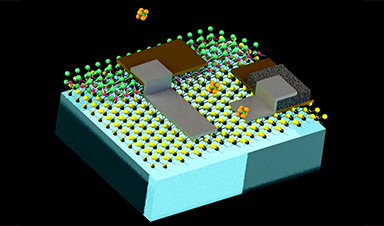AEROSOLS FOR GOOD. You may have sworn off aerosol sprays in the ’90s when everyone was talking about the hole in the ozone layer, but a team of researchers from MIT has found a use for aerosols that could be good for both the environment and our health. This spray contains nanobots, tiny sensors with the potential to do everything, from detecting dangerous leaks in pipelines, to diagnosing health issues. They published their research in Nature Nanotechnology on Monday.
NANO-SCALE SENSORS. Each sensor in the aerosol spray contains two parts. The first is a colloid, an extremely tiny insoluble particle or molecule. Colloids are so small, in fact, they can remain suspended in a liquid or the air indefinitely — the force of particles colliding around them is stronger than the force of gravity attempting to pull them down.
The second part of the sensor is a complex circuit containing a chemical detector built from a two-dimensional material, such as graphene. When this detector encounters a certain chemical in its environment, its ability to conduct electricity improves. The circuit also contains a photodiode, a device that can convert ambient light into electric current. This provides all the electricity needed to power the circuit’s data collection and memory.
Image Credit: Futurism.com
News This Week
Repurposed drugs could calm the immune system’s response to nanomedicine
An international study led by researchers at the University of Colorado Anschutz Medical Campus has identified a promising strategy to enhance the safety of nanomedicines, advanced therapies often used in cancer and vaccine treatments, [...]
Nano-Enhanced Hydrogel Strategies for Cartilage Repair
A recent article in Engineering describes the development of a protein-based nanocomposite hydrogel designed to deliver two therapeutic agents—dexamethasone (Dex) and kartogenin (KGN)—to support cartilage repair. The hydrogel is engineered to modulate immune responses and promote [...]
New Cancer Drug Blocks Tumors Without Debilitating Side Effects
A new drug targets RAS-PI3Kα pathways without harmful side effects. It was developed using high-performance computing and AI. A new cancer drug candidate, developed through a collaboration between Lawrence Livermore National Laboratory (LLNL), BridgeBio Oncology [...]
Scientists Are Pretty Close to Replicating the First Thing That Ever Lived
For 400 million years, a leading hypothesis claims, Earth was an “RNA World,” meaning that life must’ve first replicated from RNA before the arrival of proteins and DNA. Unfortunately, scientists have failed to find [...]
Why ‘Peniaphobia’ Is Exploding Among Young People (And Why We Should Be Concerned)
An insidious illness is taking hold among a growing proportion of young people. Little known to the general public, peniaphobia—the fear of becoming poor—is gaining ground among teens and young adults. Discover the causes [...]
Team finds flawed data in recent study relevant to coronavirus antiviral development
The COVID pandemic illustrated how urgently we need antiviral medications capable of treating coronavirus infections. To aid this effort, researchers quickly homed in on part of SARS-CoV-2's molecular structure known as the NiRAN domain—an [...]
Drug-Coated Neural Implants Reduce Immune Rejection
Summary: A new study shows that coating neural prosthetic implants with the anti-inflammatory drug dexamethasone helps reduce the body’s immune response and scar tissue formation. This strategy enhances the long-term performance and stability of electrodes [...]
Scientists discover cancer-fighting bacteria that ‘soak up’ forever chemicals in the body
A family of healthy bacteria may help 'soak up' toxic forever chemicals in the body, warding off their cancerous effects. Forever chemicals, also known as PFAS (per- and polyfluoroalkyl substances), are toxic chemicals that [...]














Leave A Comment